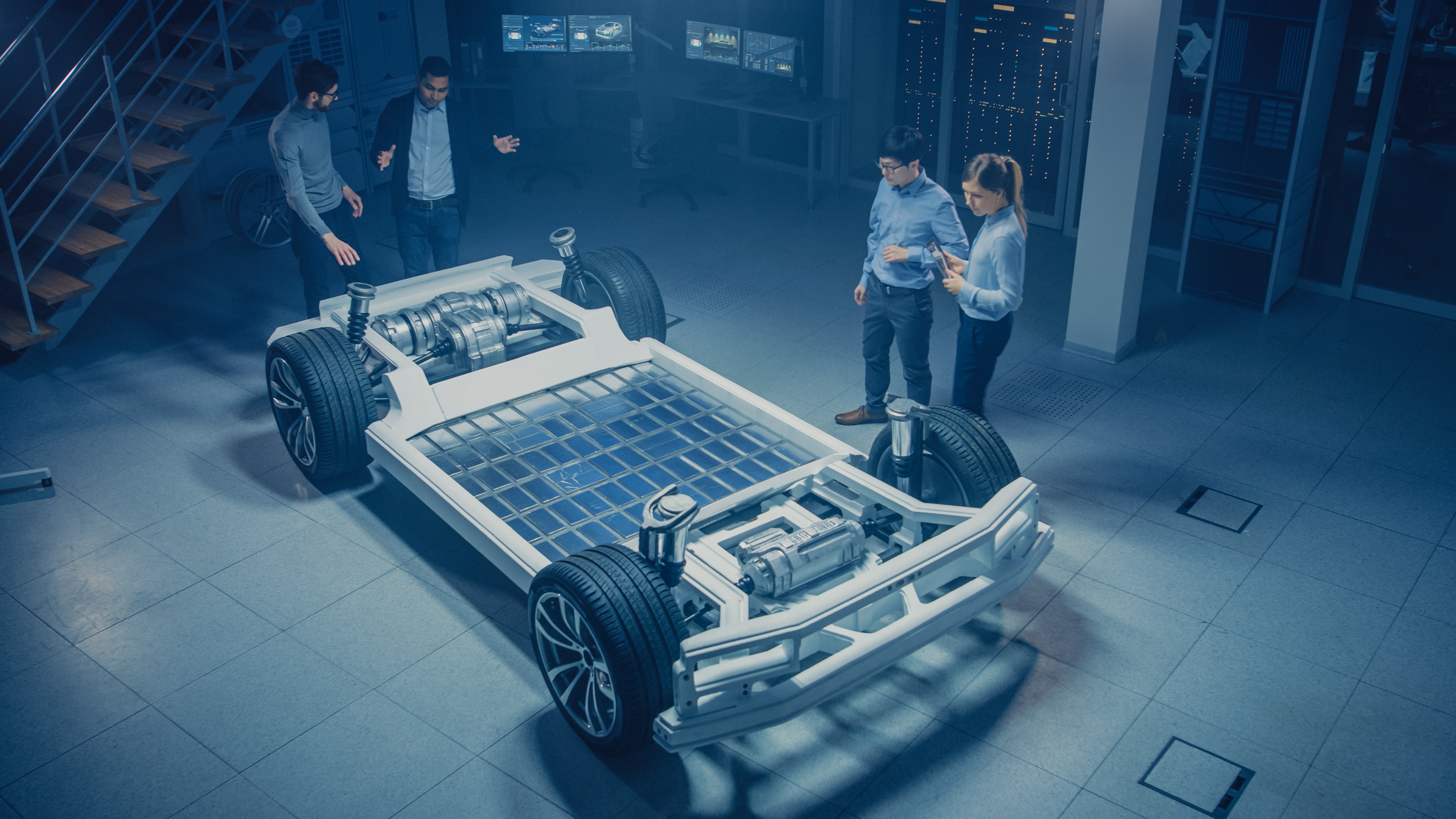
Electric vehicles (EVs) have emerged over the past decade as a key tool in the fight against transport-related emissions—and climate change. As a result, the global EV stock is expected to increase from 11 million in 2020 to over 145 million by 2030. Many car manufacturers have also pledged to transition completely to EVs in the next five to ten years; including Jaguar, Audi, GM, and Mercedes. At the same time, governments around the world, including the EU, are incentivizing the purchase of electric vehicles.
With the rise of EVs as an alternative to internal combustion engine (ICE) vehicles, one important question pops up: how sustainable are electric vehicles in reality? The answer is, just like with anything to do with sustainability, more complicated than at first glance.
Environmental impact of electric cars
Over its lifetime, the environmental impact of an electric car is a lot lower compared to its gas-powered counterpart. But this doesn’t mean there is no impact at all. So let’s break it down.
By their nature, battery electric vehicles produce no direct emissions from fuel combustion, but may still emit some CO2 depending on how the electricity to power them was generated. However, carbon emissions from powering an EV makeup only a fraction of its total environmental impact. From the extraction of the raw materials through to battery production and recycling at the vehicle’s end of life, this article examines the impact each step has on our planet.

Key takeaways
- Manufacturing: Because of a complex and resource-intensive manufacturing process, an EV uses twice as much energy and emits more CO2 than an ICE vehicle during its manufacturing.
- In use: Because EVs don’t burn diesel or gasoline, their environmental impact reaches parity with a combustion engine car at about 33,000 km. Above that, an EV becomes more sustainable in terms of emissions.
- End-of-life: At the end of its life, an EV—and especially its battery—requires special handling. Beyond upcycling the battery itself in less demanding processes—which can give it a second, third, or even fourth life—it’s possible to recycle up to 90 percent of a battery’s materials.
Here at EVBox, we believe the future of transportation is electric. For this article, we’ve based our research on independent data and reputable sources to paint as accurate a picture as possible.
Are electric cars really better for the environment?
Whereas gas-powered vehicles’ environmental impact stems mainly from their use, electric vehicles pollute the most during their manufacturing and end of life. In particular, their batteries are a key focus point due to the materials they contain and the environmental and social implications of handling them.

Lithium mining for batteries
Most modern electric cars are powered by lithium-ion batteries. Apart from lithium, they rely on a number of elements such as cobalt, manganese, nickel, and graphite, some of which are energy-intensive to mine and concentrated in regions with poor human rights and environmental records.
Electric car battery mining labor practices
Concerns about labor practices are present at several stages in the supply chain for the raw materials required to produce EV batteries. For example, about ⅔ of the world’s cobalt comes from the Democratic Republic of the Congo (DRC), one of the poorest countries on Earth. With little formal regulation, mining is often done at a small scale by individuals lacking adequate protective equipment, training, and tools. Miners often expose themselves to dangerous chemicals and work in precarious conditions. With little to no government oversight, there is also a risk of child and forced labor.
In an attempt to combat these poor conditions, most major car manufacturers have pledged to source cobalt, graphite, and lithium from responsible and traceable sources. At the same time, battery manufacturers are increasingly shifting away from cobalt, focusing instead on more readily available and less problematic materials such as nickel or iron. New research on solid-state batteries promises to do away entirely with cobalt and massively improve the performance and capacity of new batteries.
Although battery technology is widespread, its use to power EVs is still in its infancy. As prices continue to drop and innovation continues, policymakers and industry leaders have a responsibility to improve the labor practices associated with mining and developing batteries.
Lithium ion battery environmental impact
Beyond social implications, mining for materials such as lithium can also negatively impact the environment. For instance, lithium is most commonly produced by extracting it from salt flats, leaving behind a toxic leachate that needs to be stored and cleaned. Because of its water intensity, lithium extraction can also exacerbate droughts and deprive local communities of sufficient water for drinking and irrigation.
Supply challenges for EV batteries
The explosive rise of EVs in recent years, coupled with a general increase in the use of consumer electronics, is fuelling an unprecedented growth in battery demand. Currently, Australia, China, Canada, and Brazil produce the majority of the world’s lithium, graphite, and nickel needed for battery production. To meet this growing demand, avoid production shortages, and shore up supply chains, new lithium production technologies are emerging.
While EV supply chains today may not be considered entirely ethical or waste-free, the production of batteries used in EVs is becoming more sustainable as innovation accelerates and manufacturers switch away from polluting minerals.
Carbon emissions from battery production
Producing lithium-ion batteries is highly energy-intensive: from mining to processing, shipping, and manufacturing, the journey from raw material to finished product is long and arduous. Because of this, EVs use twice the energy and emit more CO2 during their manufacturing than ICE cars.
However, the picture changes once we look at the total lifecycle. Once an EV is manufactured, it produces very low emissions, requiring no diesel or gasoline to power its engine. According to a Wall Street Journal estimation that compared a Tesla Model 3 with a Toyota RAV4, the Tesla becomes more sustainable after about 33,000 km and emits 77 percent less CO2 after 160,000 km.

How long are car batteries good for?
All batteries have a limited lifespan: every charge and discharge cycle introduces small chemical changes that accumulate over time to reduce the total energy a battery can hold. EV batteries are no exception and will wear out after a certain number of charges. Under current estimates, most EV batteries will last somewhere between 10-20 years before they need to be replaced.
Modern EVs are designed with batteries capable of being recharged thousands of times, lasting for hundreds of thousands of kilometers. Most manufacturers offer warranties on battery packs for at least 100,000 km and eight years, which covers a large proportion of the car’s lifespan. Even once out of warranty, batteries have been reported to last much longer, with several Teslas having exceeded 1 million kilometers with little battery degradation.
EV battery recycling and repurposing
Even with the increasing lifespan of EV batteries, there will come a point where they are no longer suitable for powering a vehicle. But it doesn’t mean they have to go to waste: there are countless possibilities for reusing and recycling a used EV battery.
Just because a battery can no longer power a car, it doesn’t mean it cannot be used to store energy for other purposes. One of the key challenges of renewable energies is storage: the wind doesn’t always blow, and the sun doesn’t always shine when we need it. EV batteries can have a second life capturing excess energy from renewable sources and feeding it back to the grid when required.
The Johan Cruijff Arena in Amsterdam, for example, uses a 3-megawatt storage solution made from old Nissan Leaf batteries to provide backup power and smoothen the peaks that occur during events.
For batteries that cannot be repurposed, recycling allows their materials to be recovered and reused. Currently, battery recycling technology is still in its early stages, but new processes allow up to 90 percent of the lithium and cobalt to be retrieved. With the growing demand for these materials, old EV batteries are a sustainable pool of resources to fuel the transition to electric mobility.
EVs as a catalyst for sustainable technology
While EVs may not be the sole solution to overcoming climate change, they play an essential role in stimulating the development of other sustainable technologies. For instance, the rapid development of battery technology for EVs has made storing renewable energy much more efficient—a key aspect in the energy transition. Similarly, smart building technologies for balancing electricity demand, such as peak shaving and dynamic load balancing, are fuelled by the growing adoption of EVs and the need to maximize energy use. Plus, beyond the immediate catalytic effects, the commercial viability of sustainable alternatives such as EVs has opened the door to investment in climate technologies across the mobility industry.
So, are EVs sustainable?

EVs are, by themselves, not a magic solution for addressing climate change. However, they are a valuable tool for reducing emissions from transportation and a far more sustainable alternative to fossil fuel-powered cars. While their production and end-of-life have a negative impact on the environment, their overall carbon footprint is much lower than fuel-burning vehicles when compared over the life cycle. And with the innovation in the sector moving forward in leaps and bounds, the EVs of tomorrow are likely to extend the sustainability gap with traditional vehicles.
Related articles

Smart Charging for Solar EV Systems: What is possible today?
There are a variety of smart solutions available, capable of optimizing your solar EV charging system in different...

Can solar EV charging save you money?
Charging your EV using household solar panels can indeed save you money on your utility bills. How much money solar EV...

How to optimize your solar set-up for charging electric cars at home
There are several ways EV drivers can optimize a homegrown solar system to ensure their EV recharging needs are met....
